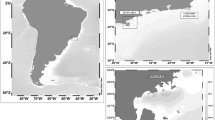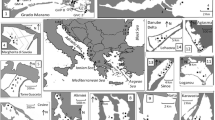Abstract
This study examined how the species composition of an intertidal barnacle guild varied according to physical gradients in the environment at small scales governed by microclimates, medium scales of wave exposure and large scales of latitude. Barnacle distributions at small and medium scales were sampled in Ireland between 51°29′ and 52°44′N and 6°50′ and 10°08′W. Sampling on European shores spanned ~18° latitude from 37°05′ to 55°16′N. Barnacle surveys mainly took place in 2003–2004. An index of wave fetch was calculated along the wave exposure gradient using a digital coastline-based model that was supported by a biological exposure scale. A ‘dryness’ index was defined according to mean monthly wind speed, fetch along the average wind direction and mean monthly air or sea surface temperatures for 2 years (January 2001–December 2002) which is the period when the most recent adults in the barnacle community would have settled and grown to adulthood. The proportion of the dry-loving barnacle Chthamalus montagui Southward increased within the barnacle guild at all scales as the habitat became warmer and drier. Barnacle densities were high in all habitats, mean densities ranged from a minimum of 4.16 cm−2 on moderately exposed shores to a maximum of 6.27 cm−2 in sunlit or south-facing microclimates. Percentage cover of barnacles across the gradient of latitudes was usually >70%. The results suggest that the distribution and abundance of interacting barnacle species on European coasts is strongly controlled by abiotic factors, most likely temperature and desiccation.





Similar content being viewed by others
References
Allen BM, Power AM, O’Riordan RM, Myers AA, McGrath DM (2006) Increases in the abundance of the invasive barnacle Elminius modestus Darwin in Ireland. Biol Environ Proc R Irish Acad 106:155–161
Ballantine WJ (1961) A biologically-defined exposure scale for the comparative description of rocky shores. Field Stud 1:1–19
Burrows MT (1985) Predation by Nucella lapillus on barnacles. Porcup Newsl 3:64–66
Burrows MT (1988) The comparative biology of Chthamalus stellatus (Poli) and Chthamalus montagui Southward. PhD Dissertation, University of Manchester, Manchester
Burrows MT, Harvey R, Robb L (2008) Wave exposure indices from digital coastlines and the prediction of rocky shore community structure. Mar Ecol Prog Ser 353:1–12
Connell JH (1961) The influence of interspecific competition and other factors on the distribution of the barnacle Chthamalus stellatus. Ecology 42:710–723
Connell JH (1975) Some mechanisms producing structure in natural communities: a model and evidence from field experiments. In: Cody M, Diamond J (eds) Ecology and evolution of communities. Harvard University Press, Cambridge, pp 460–490
Crapp GB (1973) The distribution and abundance of animals and plants on the rocky shore of Bantry Bay. Irish Fish Investig (New Ser) 9:1–35
Crisp DJ, Southward AJ (1958) The distribution of intertidal organisms along the coasts of the English Channel. J Mar Biol Assoc UK 37:157–208
Crisp DJ, Southward AJ, Southward EC (1981) On the distribution of the inter-tidal barnacles Chthamalus stellatus, Chthamalus montagui and Euraphia depressa. J Mar Biol Assoc UK 61:359–380
Davenport J, Davenport JL (2005) Effects of shore height, wave exposure and geographical distance on thermal niche width of intertidal fauna. Mar Ecol Prog Ser 292:41–50
Davis AJ, Jenkinson LS, Lawton JH, Shorrocks B, Wood S (1998) Making mistakes when predicting shifts in species range in response to global warming. Nature 391:783–786
Delany J, Myers AA, McGrath D, O’ Riordan RM, Power AM (2003) Role of post-settlement mortality and ‘supply-side’ ecology in setting patterns of intertidal distribution in the chthamalid barnacles Chthamalus montagui and C. stellatus. Mar Ecol Prog Ser 249:207–214
Finke GR, Navarrete SA, Bozinovic F (2007) Tidal regimes of temperate coasts and their influences on aerial exposure for intertidal organisms. Mar Ecol Prog Ser 343:57–62
Foster BA (1969) Tolerance of high temperature of some intertidal barnacles. Mar Biol 4:326–332
Foster BA (1971a) Desiccation as a factor in the intertidal zonation of barnacles. Mar Biol 8:12–29
Foster BA (1971b) On the determinants of the upper limit of the intertidal distribution of barnacles (Crustacea: Cirripedia). J Anim Ecol 40:33–48
Garrity SD (1984) Some adaptations of gastropods to physical stress on a tropical rocky shore. Ecology 65:559–574
Goldenberg SB, Landsea CW, Mestas-Nuñez AM, Gray WM (2001) The recent increase in Atlantic hurricane activity: causes and implications. Science 293:474–479
Hampe A (2004) Bioclimate envelope models: what they detect and what they hide. Global Ecol Biogeogr 13:469–470
Harley CDG (2003) Abiotic stress and herbivory interact to set range limits across a two-dimensional stress gradient. Ecology 84:1477–1488
Harley CDG, Lopez JP (2003) The natural history, thermal physiology, and ecological impacts of the intertidal mesopredators, Oedoparena spp. (Diptera: Dryomyzidae). Invertebr Biol 122:61–73
Harley CDG, Hughes AR, Hultgren KM, Miner BG, Sorte CJB, Thornber CS, Rodriguez LF, Tomanek L, Williams SL (2006) The impacts of climate change in coastal marine systems. Ecol Lett 9:228–241
Haylock MR, Hofstra N, Klein Tank AMG, Klok EJ, Jones PD, New M (2008) A European daily high-resolution gridded dataset of surface temperature and precipitation. J Geophys Res (Atmospheres) 113:D20119. doi:10.1029/2008JD10201
Helmuth B, Harley CDG, Halpin PM, O’Donnell M, Hofmann GE, Blanchette CA (2002) Climate change and latitudinal patterns of intertidal thermal stress. Science 298:1015–1017
Intergovernmental Panel for Climate Change (1996) Climate change 1995: the science of climate change. In: Houghton JT, Meira Fihlo LG, Callender BA, Harris N, Kattenberg A, Maskell K (eds) Contribution of WG1 to the second assessment report of the intergovernmental panel on climate change. Cambridge University Press, UK
Jenkins SR (2005) Larval habitat selection, not larval supply, determines settlement patterns and adult distribution in two chthamalid barnacles. J Anim Ecol 74:893–904
Johnson MP, Hughes RN, Burrows MT, Hawkins SJ (1998) Beyond the predation halo: small scale gradients in barnacle populations affected by the relative refuge value of crevices. J Exp Mar Biol Ecol 231:163–170
Lewis JR (1955) The mode of occurrence of the universal intertidal zones in Great Britain. J Ecol 43:270–290
Miller JC (1980) Niche relationships among parasitic insects occurring in a temporary habitat. Ecology 61:270–275
O’Riordan RM, Ramsay NF (1999) The current distribution and abundance of the Australasian barnacle Elminius modestus in Portugal. J Mar Biol Assoc UK 79:937–939
O’Riordan RM, Power AM, Myers AA (2010) Factors, at different scales, affecting the distribution of species of the genus Chthamalus Ranzani (Cirripedia, Balanomorpha, Chthamaloidea). J Exp Mar Biol Ecol 392:46–64
Parmesan C, Gaines S, Gonzalez L, Kaufmann DM, Kingsolver J, Townsend Peterson A, Sagarin R (2005) Empirical perspectives on species borders: from traditional biogeography to global change. Oikos 108:58–75
Pearson RG, Dawson TP (2003) Predicting the impacts of climate change on the distribution of species: are bioclimate envelope models useful? Global Ecol Biogeogr 12:361–371
Poloczanska ES, Hawkins SJ, Southward AJ, Burrows MT (2008) Modeling the response of populations of competing species to climate change. Ecology 89:3138–3149
Pörtner HO (2001) Climate change and temperature-dependent biogeography: oxygen limitation of thermal tolerance in animals. Naturwissenschaften 88:137–146
Power AM, Myers AA, O’ Riordan RM, McGrath D, Delany J (2001) An investigation into rock surface wetness as a parameter contributing to the distribution of the intertidal barnacles Chthamalus stellatus and C. montagui. Estuar Coast Shelf Sci 52:349–356
Power AM, Delany J, McGrath D, Myers AA, O’ Riordan RM (2006) Patterns of adult abundance in Chthamalus stellatus (Poli) and C. montagui Southward (Crustacea: Cirripedia) emerge during late recruitment. J Exp Mar Biol Ecol 332:151–165
Range P, Paula J (2001) Distribution, abundance and recruitment of Chthamalus (Crustacea: Cirripedia) populations along the central coast of Portugal. J Mar Biol Assoc UK 81:461–468
Rayner NA, Parker DE, Horton EB, Folland CK, Alexander LV, Rowell DP, Kent EC, Kaplan A (2003) Global analyses of sea surface temperature, sea ice, and night marine air temperature since the late nineteenth century. J Geophys Res 108:D14, 4407. doi:10.1029/2002JD002670
Schoener TW (1983) Field experiments on interspecific competition. Am Nat 122:240–285
Seierstad IA, Stephenson DB, Kvamstø NG (2007) How useful are teleconnection patterns for explaining variability in extratropical storminess? Tellus 59A:170–181
Simkanin CS, Power AM, Myers A, McGrath D, Southward AJ, Mieszkowska N, Leaper R, O’Riordan R (2005) Using historical data to detect temporal changes in the abundances of intertidal species. J Mar Biol Assoc UK 85:1329–1340
Sousa EB, Cruz T, Castro JJ (2000) Distribution and abundance of co-occurring chthamalid barnacles Chthamalus montagui and C. stellatus (Crustacea: Cirripedia) on the southwest coast of Portugal. Hydrobiologia 440:339–345
Southward AJ (1958) The zonation of plants and animals on rocky sea shores. Biol Rev Camb Philos Soc 33:137–177
Southward AJ (1976) On the taxonomic status of Chthamalus stellatus (Cirripedia) in the North-East Atlantic region: with a key to the common intertidal barnacles of Britain. J Mar Biol Assoc UK 56:1007–1028
Southward AJ (1991) Forty years of changes in species composition and population density of barnacles on a rocky shore near Plymouth. J Mar Biol Assoc UK 71:495–513
Southward AJ, Crisp DJ (1954) Recent changes to the distribution of the intertidal barnacles Chthamalus stellatus Poli and Balanus balanoides L. in the British Isles. J Anim Ecol 23:163–177
Southward AJ, Hawkins SJ, Burrows MT (1995) Seventy years’ observations of changes in distribution and abundance of zooplankton and intertidal organisms in the western English Channel in relation to rising sea temperature. J Therm Biol 20:127–155
Stephenson TA, Stephenson A (1972) Life between the tidemarks on rocky shores. WH Freeman & Co, San Francisco
Stillman JH (2003) Acclimation capacity underlies susceptibility to climate change. Science 301:65
Wethey DS (1983) Geographic limits and local zonation: the barnacles Semibalanus (Balanus) and Chthamalus in New England. Biol Bull Mar Biol Lab Woods Hole 165:330–341
Wethey DS (1984) Sun and shade mediate competition in the barnacles Chthamalus and Semibalanus: a field experiment. Biol Bull Mar Biol Lab Woods Hole 167:176–185
Wethey DS (2002) Biogeography, competition, and microclimate: the barnacle Chthamalus fragilis in New England. Integr Comp Biol 42:872–880
Wethey DS, Woodin SA (2008) Ecological hindcasting of biogeographic responses to climate change in the European intertidal zone. Hydrobiologia 606:139–151
Acknowledgments
We wish to thank the Irish Marine Institute for funding (Ref: PDOC/01/006) and Dr. Mike Burrows, Dr. Rebecca Leaper, Niall McGinty and Dr. Julio Arrontes for various help. Special thanks to Eoin MacLoughlin and the late Dr. Jimmy Dunne for collection of barnacle samples in France. We would also like to thank two referees for very valuable suggestions.
Author information
Authors and Affiliations
Corresponding author
Additional information
Communicated by S. D. Connell.
Rights and permissions
About this article
Cite this article
Power, A.M., McCrann, K., McGrath, D. et al. Physiological tolerance predicts species composition at different scales in a barnacle guild. Mar Biol 158, 2149–2160 (2011). https://doi.org/10.1007/s00227-011-1720-9
Received:
Accepted:
Published:
Issue Date:
DOI: https://doi.org/10.1007/s00227-011-1720-9




